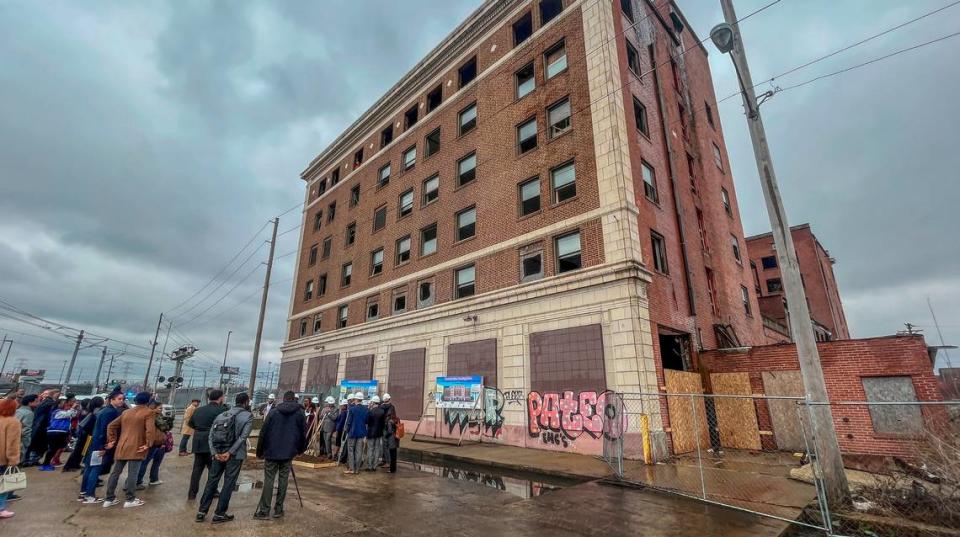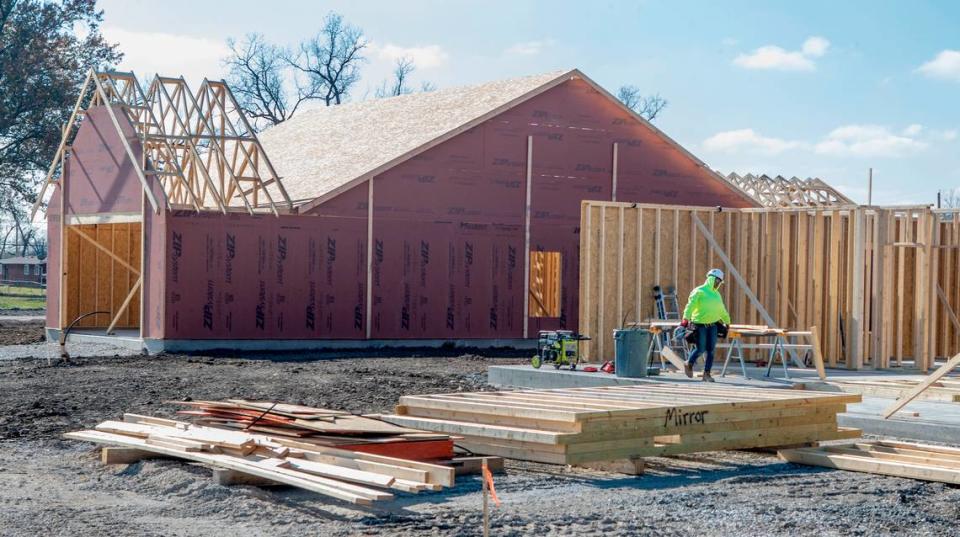Where are most vacant homes in St. Clair County and what can communities do about it?
In some places in St. Clair County, as much as 20% of the homes were sitting empty when the government took a snapshot of the community for the latest census, new data shows.
More than a dozen communities had vacancy percentages over 10%, including East St. Louis, Belleville and Caseyville.
For residents, vacant homes can be unwelcome eyesores in their neighborhood, safety hazards or a drain on property values. They can also cost local governments.
Fire, police and code enforcement officials get called to address problems at vacant homes. Governments may eventually pay to abate nuisances or demolish the buildings entirely. And while they sit empty, these homes aren’t generating tax revenue for the community.
Some circumstances, like a death with no estate plan or an out-of-town investor, can make a vacancy more complicated to resolve. But experts say there are steps communities can take to address problem properties .
“We say the greatest cost is doing nothing and just allowing the status quo to sustain,” said Tarik Abdelazim, who works for the nonprofit Center for Community Progress.
Abdelazim is the director of national technical assistance for the Center for Community Progress, which is the only national nonprofit dedicated to tackling vacant properties, according to the nonprofit’s website.
It’s important to take action because unmaintained properties can lead to consequences for the larger community, according to Bob Palmer, policy director at Housing Action Illinois, a statewide coalition advocating for more quality, affordable housing.
“Housing vacancies can contribute to a cycle of population loss and furthered disinvestment from the community, worsening of housing standards in other parts of the community,” he said.
Are there vacant homes in your community?
The Belleville News-Democrat analyzed the new housing data, which was released in May, for 26 cities and villages in St. Clair County and found:
In 14 communities, over 10% of the homes were vacant during the 2020 census: Washington Park, Sauget, East St. Louis, Cahokia, Alorton, Centreville, Belleville, Caseyville, Marissa, Brooklyn, Lenzburg, East Carondelet, Lebanon and Dupo. (Cahokia, Alorton and Centreville merged to become the new city of Cahokia Heights in 2021.)
Vacancy percentages in the country and state were lower than those communities. About 10% of homes in the U.S. were vacant. In Illinois, about 8% of homes were vacant.
In St. Clair County and across the country, vacant properties are most often concentrated in poor, predominantly Black communities. One reason for that is the country’s history of discriminatory housing laws and policies, according to Abdelazim, of the Center for Community Progress.
He said those policies included redlining and racial covenants, which restricted Black residents’ access to mortgages and homes in suburban neighborhoods.
Meanwhile, white residents moved, shrinking the tax base needed to maintain roads, water and sewer infrastructure and other public services. That kind of disinvestment has ripple effects in private sector housing and business investments in a community, according to Abdelazim.
Here’s what else to know about the new Census data:
The number of homes has decreased every decade since 2000 in nine communities: Washington Park, Sauget, East St. Louis, Cahokia, Alorton, Centreville, Marissa, Brooklyn and Lenzburg.
The number of homes has increased every decade in 11 communities: Caseyville, Lebanon, Fairview Heights, St. Libory, Swansea, Shiloh, Mascoutah, Freeburg, O’Fallon, Millstadt and Smithton.
This data release comes with a caveat. The U.S Census Bureau adds “statistical noise” — small, random additions or subtractions — to all of its data to protect citizens’ confidentiality. The agency says this measure ensures no one can link the data to a specific person or household with any certainty.
The Census Bureau counted properties as vacant if they were abandoned by the homeowner or the owner stopped making mortgage or tax payments, leading to foreclosure. It also counted homes tied up in legal disputes like divorce or eviction proceedings and those sitting empty during family disruptions, including homeowners who died or moved to an assisted living facility.
The agency counted homes as vacant if they were for sale or for rent. It also counted homes that were sold or rented but the new resident had not moved in yet.
New development gets classified as vacant housing, too — as soon as construction reaches the point where exterior windows and doors are installed and usable floors are in place.
The Census Bureau does not include properties in its count that are exposed to the elements because they are missing a roof, walls, windows or doors. Houses that are clearly about to be demolished or are condemned because of signage on the home are also not counted.
What communities can do — and are doing — to improve housing
Palmer, of Housing Action Illinois, said one option for communities with vacant homes is direct government investment to maintain and rehab uninhabited housing, including demolishing when deemed necessary.
In St. Clair County, the city of Belleville regularly buys residential buildings that have been forfeited to the county due to unpaid property taxes by bidding on them at auction. The city invites developers and investors to inspect salvageable buildings and submit proposals. It has also torn down more than 60 homes in the past decade.
Belleville had more vacant homes in the 2020 census than any of the other 25 communities whose data the BND analyzed.
The communities with the next highest number of vacant homes were East St. Louis and Cahokia Heights, which are getting help from the state government, an Illinois housing agency and local nonprofit to address their housing needs.
The city of East St. Louis is renovating the historic Broadview Hotel into affordable housing for veterans and residents who are 55 years old and older with $25.3 million in state tax credits and more than $10 million in state funding.

Community nonprofit Lansdowne Up is also working to redevelop the Lansdowne neighborhood in East St. Louis by clearing lots, renovating existing homes and building new ones, including a subdivision with 20 market-rate homes.
Both East St. Louis projects are expected to be completed by next year.

Meanwhile, Cahokia Heights has been working with the Illinois Housing Development Authority on a community revitalization plan focused on housing.
The state Housing Development Authority notes in a 179-page planning document that the partnership is to help Cahokia Heights strategize and is not necessarily a promise of funding.
Andrew Field, a spokesperson for the agency, said the partnership resulted in a housing stock survey through which volunteers assessed vacancies. Volunteers also surveyed residents about condition, availability and affordability of housing in their community.
“There’s a lot of vacant properties that could be renovated and sold or rented for affordable housing,” one survey respondent said.
Respondents also noted the city needs infrastructure improvements, including to the sewer system. Some residents in Cahokia Heights have experienced raw sewage backups and flooding in their homes, yards and streets for decades. State and federal money has been promised toward work on the infrastructure.
Another option for communities to address vacant homes is through land banks, a tool the Center for Community Progress supports.
Land banks are public entities that acquire problem properties and temporarily hold and take care of them until they can be sold to new owners, the Center for Community Progress explains on its website.
Abdelazim held up New York as an example of their success. In a 10-year impact report, the Center for Community Progress reported that the state’s land banks:
Acquired over 5,000 properties.
Spurred $480 million in neighborhood investments.
Returned an estimated $134 million in assessed value to the tax rolls.
Generated nearly $56 million in sales proceeds, which were rolled back into land bank interventions or shared with local and county governments to support other public services.
The nonprofit attributed the achievements to “forward-thinking public officials and creative practitioners who acknowledged the traditional tax auction was no way to resolve vacant, abandoned, and dilapidated properties and that a bolder approach was possible,” the report states.
Reporter Teri Maddox contributed information to this report.

